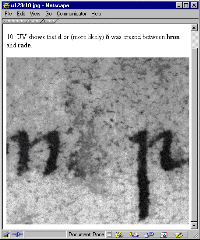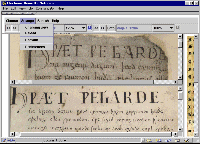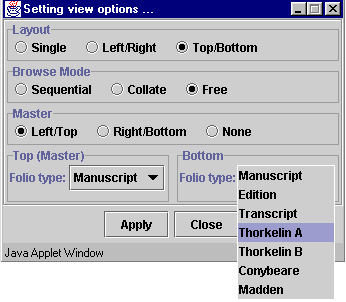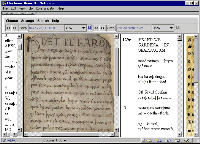William Kilbride, Dept of Archaeology, University Of York, England YO1 7EP
Cite this as: Kilbride, W. 2000 Whose Beowulf is it anyway? Review of Electronic Beowulf [CD-Rom], Internet Archaeology 9. https://doi.org/10.11141/ia.9.12
Electronic Beowulf, edited by K. Kiernan, with Andrew Presscott, Elizabeth Solopova, David French, Linda Cantara, Michael Ellis and Cheng Jiun Yuan. Published by the British Library and the University of Michigan Press http://www.bl.uk
Minimum System Requirements: PC running Windows 95 or 98 or NT 4.0: Pentium 133MHz or faster
processor; 32 MB RAM minimum; Netscape 4.5 or higher or MS IE 5.0; Sun Microsystems Java plugin (installation included with CD). Power Macintosh (G3 recommended) running OS 8.1 or higher: 32MB RAM
minimum; Netscape 4.61; MRJ plugin and Times OE font (installation included with CD).
ISBN 0-71230494-0. Price: 95 ukp + VAT from the British Library Bookshop, 96 Euston Road, London NW1 2DB. Email: bookshop@bl.uk
'Beowulf? .... that's by Seamus Heaney. Sorry we're sold out.'
It is hardly surprising that Heaney's new translation of Beowulf should seem like a completely new work. It has been a very long time since Grendel's mother was on the archaeology reading list, let alone among the best sellers. The new translation has a parallel, less popular but in many respects more interesting, product from the British Library in the shape of Electronic Beowulf, a CD-Rom (or two) which provides virtual access to the medieval manuscript itself.
Access to information is a modern zeitgeist. The British Library's Electronic Beowulf is part of a programme that will bring us the digital Gutenburg Bible, the electronic Magna Carta and many more. Similar projects at the Public Records Office promise to provide 'Access to Archives'. The Heritage Lottery Fund (HLF) and the New Opportunities Fund (NOF) both now fund digitisation projects, the latter spending 50 million UKP specifically to make information accessible on the Internet. These initiatives are not formulated in isolation, but form parts of wider social and economic policies. UK government policy on information aims to use this investment not simply to disseminate information, but, we are told:
"The Government has a mission to modernise - renewing our country for the new millennium. We are modernising our schools, our hospitals, our economy and our criminal justice system. We are modernising our democratic framework"
(Tony Blair, foreword to HMSO 1999).
Allied to this, ambitious policies to combat 'social exclusion' have accentuated wider issues of social and cultural regeneration, with emphasis being placed on the culture and heritage sectors as a means of engaging actively with groups disenfranchised by conventional social and economic policies (e.g. SEU 2000). Cultural engagement for social regeneration is paralleled by a recognition of the importance of new technologies in the economy, represented by exercises such as the Department of Trade and Industry's "UK online for business" programme. Investment in digital infrastructures will provide the foundations for a wider economic engagement, raising standards in IT skills, and providing a platform from which business can expand its use of communications technologies. For many years governments have supported industry with the infrastructure of roads, railways and ports. In the 'information age' the 'knowledge economy' will receive a similar sort of investment. This, at least is the political theory of community building on the Internet.
This rhetoric is all well and good, but it seems to take us a long way from Electronic Beowulf. The point is, however, that Electronic Beowulf provides an early taste of what is to come. Once NOF, HLF and everyone else have spent their millions, then there's no question that the review pages of Internet Archaeology will be stuffed with virtual galleries, virtual museums, virtual worlds, virtually everything. Does Electronic Beowulf, support this rhetoric of access and inclusion?
The history of the text of Beowulf is almost as dramatic as the adventure it narrates. The earliest manuscript (perhaps) belongs to the 11th century. After the dissolution of the monasteries, it came into the possession of Laurence Nowell. It was acquired in the 17th century by Robert Cotton, who donated it to the state in 1700. The manuscript survived fire in 1731, before being moved to the British Museum on its foundation in 1753. The charred and disintegrating remains of the manuscript were studied by the Danish scholar, G.J. Thorkelin, whose library was wrecked and papers destroyed by the Royal Navy in 1807 during the siege of Copenhagen. Collations in 1817 and 1824 demonstrate the manuscript's rapid decay before finally being conserved in 1845. It was among the first texts published as a photographic facscimile (Zupitza 1882), among the earliest manuscripts analysed under ultra-violet light (Smith 1938) and has recently been subjected to innovative fibre-optic study (Kiernan 1984).

An ultra-violet close up of the space between two letters showing that a
third letter was erased by the clerk who prepared the manuscript. An
intuitive navigation tool highlights numerous similar examples of
damaged or erased letters that have been identified by scholars working
on the manuscript.
At the core of Electronic Beowulf is not one but several Beowulfs. The prize in some respects is the 11th century manuscript bound into the Cotton Vitellius A XV Codex, and including the other manuscripts that were bound with it, such as the Soliloquies of Saint Augustine and a fragment of the Anglo-Saxon poem Judith, which deserve more in the way of commentary than they receive. The high-resolution images are supplemented by close-up back-lit and ultra-violet images that show letters now lost to the naked eye, either because of corrections made in antiquity, or obscured during conservation. These images are presented as 'hot spots' on the text and are navigated effectively and cleanly, with a clever tool allowing the user a simple view of the manuscript or an interactive view that highlights parts of the text that have been lost or found. All this is supported by a hypertext dictionary for those of us whose Old English isn't what it ought to be, and a series of articles describing the project and the methods used to capture the text.

The eleventh century manuscript can be compared to later transcriptions,
including two transcriptions prepared by GJ Thorkelin at the end of the
eighteenth century. These show how the medieval manuscript has decayed,
and allow scholars to develop a critically informed reconstruction of
the parts of the manuscript now lost.
Accompanying this complete set of high-resolution images are equally high-resolution images of four early transcriptions of the poem. Finally, there is a fifth, modern, transcription and edition that highlight the multiple and at times conflicting nature of the text. The four early transcriptions reveal the extent of decay in the manuscript. Thorkelin's two transcriptions of the 1780s contain some 900 letters that had decayed or become invisible by the time Conybeare saw the manuscript in 1817. Only seven years later, Madden's transcription shows that repeated handling of the fragile and rapidly disintegrating text had resulted in the loss of some 1,900 letters - principally from the edges of the singed manuscript. This set of transcriptions demonstrate wonderfully why Thorkelin's edition may be more useful for an historical understanding than the medieval manuscript, since this has deteriorated very badly since Thorkelin's study was published.

Electronic Beowulf brings together many different versions of the text,
including the Cotton Vitellius codex and all the important
early transcriptions, as well as a modern transcription and edition.
Navigation allows these different versions to be displayed
simultaneously in a variety of forms.
Thus, Electronic Beowulf is in fact six different Beowulfs. These various texts are from many different locations. Thorkelin's transcriptions are now in the Royal Library of Denmark, while the Madden version is in the Houghton Library at Harvard University. Only the Cotton Vitellius A xv manuscript and now the Conybeare transcriptions are located in the British Library, the latter only being acquired in 1994. Never before have all these texts been available in one country, let alone in one place. Now, not only can they be studied together, but they have been brought together in an environment that makes comparison a simple matter and which incorporates the results of sophisticated analytical techniques. The effort to achieve this has been phenomenal, but the result is truly staggering. Beowulf scholars and students of Old English now have unimaginable riches at their fingertips.
I only wish I were such a scholar. There is a sense that while all these Beowulfs might be considerably more available, they remain as inaccessible as ever. For example, it seems truly remarkable that a volume so carefully designed, with several versions of the text and a dictionary, should be supplied without a simple translation of the text. It would not only be helpful for the interested amateur (or the list of cross-disciplinary scholars described in the introductory blurb accompanying the CD), but it could indeed support an interesting exercise in its own right. Comparing the text(s) to translation would demonstrate the necessity to return to source texts for an informed historical interpretation. Regrettably, Electronic Beowulf is only for those students of Anglo-Saxon culture already thoroughly steeped in the written language, not for historians or archaeologists who want to expand their knowledge. It is certainly not going to enthrall or enlighten the public, let alone make them better citizens.

As well as a complete set of high resolution images of the medieval
manuscript, Electronic Beowulf includes a complete modern transcription and edition
so that students of Old English can improve their palaeography skills, by
comparing the clean modern edition to the script of the manuscript. Search facilities
based on the modern edition further enhance the high resolutions images.
By the same token, the specifications of the computing equipment necessary to read the texts seem excessive for a product aimed at such a wide audience. The cover notes recommend a Pentium 133 with 32mb RAM and Netscape 4.5 and a Java plug-in. The software comes bundled with the product, but suffice to say that neither my own (borrowed) laptop nor (inherited) home computer could make any sense of it, while even my relatively high specification office system struggled at times. While there are undoubtedly some very large files involved, it is hard to see why such a high threshold is necessary. Savings are certainly possible that would have made the whole thing altogether more accessible. Navigation depends largely on consistent but ponderous menus written in cumbersome Javascript. Simple HTML navigation would have sufficed for much of this. A bewildering array of frames occupy the browser from time to time, but their multiplication is often unnecessary. A few design changes would make for an altogether less intimidating encounter.
So, it is arguable that Electronic Beowulf doesn't do much to empower the public or enhance our access to these highly prized assets: it simply disenfranchises us in a new way. There is an important lesson here for the political rhetoric of access. Either we need to strain every muscle to make sure that we make materials truly accessible (by providing tools like translations), or we need to be completely open about our design goals and manage expectations accordingly (it's really only for an academic audience). The former leaves us with a lot more work on our hands, the latter will leave us with much reduced funding. In the long run, either horn of the dilemma will be more comfortable than a disillusioned and excluded public.
The images will undoubtedly facilitate the preservation of the manuscript by allowing those readers already familiar with the text to address initial queries to the electronic version. Scholars who need access to the text will thus be better placed to identify the individual folios in question and thus approach the delicate manuscript more skilfully. Yet the digital copy presents its own preservation problems. A press release associated with the CD makes alarming reading, claiming that the CD is a 'complete electronic archive'. It certainly is not that.
The problems of digital archiving are beginning to be documented in slowly unfolding horror, not least by the Archaeology Data Service and its colleagues in the Arts and Humanities Data Service. A few of the problems are witnessed here, only a few months after the CD was released (March 2000). For example, the CD contains hypertext links to the British Library web site and the University of Kentucky where much of the development took place. Some of these links are already broken (assuming that they were correct in the first place) and there is no holding page to correct these errors. This demonstrates just one reason why CD is not the ideal medium for this sort of product.
Other reasons are perhaps more critical in the long term. At present there is no statutory deposit library in the UK for electronic materials, so there is no organisation mandated to maintain access to this CD-Rom in the long term. This is critical given the pace of change in digital technologies. Unscientific market research shows that computer stores in the York area sell few CD-Roms in comparison with Digital Versatile Discs. DVD's are compatible with CD's for the time being, but one can't help but think that the CD will soon join the Betamax and the Amstrad PCW in the technology which we wished we had migrated. If it were almost any organisation other than the British Library that was behind Electronic Beowulf, it would be a real cause for concern. Given recent noises from the British Library and its developing manifesto on digital preservation, I am reassured that the data underlying this edition are indeed secure in the long term, even if the CD is not.
Again, however, there is a lesson here for policy makers and aspiring cultural or heritage access programmes. When we spend millions of pounds digitising, we really only want to do it once. We certainly don't want to have to do it again in five years time. Comprehensive guidance exists for digitisation and preservation of data, most of which recommends preservation from the outset (e.g. Smith 1998). If we really do want to produce more CD-Roms, then we need to have some idea in mind regarding how we can make use of them in the long term too: which means we certainly need documentation and an idea of appropriate file formats. Once again, a little forethought may go a very long way. We certainly won't get the money to do this sort of digitisation work again, and will face quite an inquest if it goes wrong. The closure of the Millennium Dome at the end of 2000 has left the press looking for new scapegoats to blame for the misuse of taxpayers' money. Let's make sure we're not in their sights. Sustainability is not just a technical issue - it's a political one too.
It is altogether appropriate that Beowulf be in the vanguard of digitisation. But given the extraordinary rhetoric that justifies such projects and the unrestrained expectations that surround the digital revolution, Electronic Beowulf presages a paradox of inaccessible availability.
Whose Beowulf is this? What a missed opportunity to make it everyone's.
HMSO (1999) Modernising Government: Presented to Parliament by the Prime Minister and the Minister for the Cabinet Office by Command of Her Majesty, HMSO, London.
Kiernan, K.S. (1984) 'The State of the Beowulf Manuscript 1882-1983', Anglo-Saxon England 13, 23-42.
SEU (2000) National Strategy for Neighbourhood Renewal: a framework for consultation, the Social Exclusion Unit, http://www.cabinet-office.gov.uk/seu/2000/Nat_Strat_Cons/default.htm, linked from http://www.cabinet-office.gov.uk/seu/index/publishe.htm, Accessed: 21st June 2000
Smith, A. (1998) 'Preservation in the Future Tense', CLIR Issues 3, at http://www.clir.org/pubs/issues/issues03.html#preserve Accessed: 22nd December 2000
Smith, A.H. (1938) 'The Photography of Manuscripts', London Medieval Studies 1, 179-207.
Zupitza, J. (1882) 'Beowulf', Early English Text Society 77; reprinted with new photographs and an introduction by N. Davis, Early English Text Society 245 (1959).